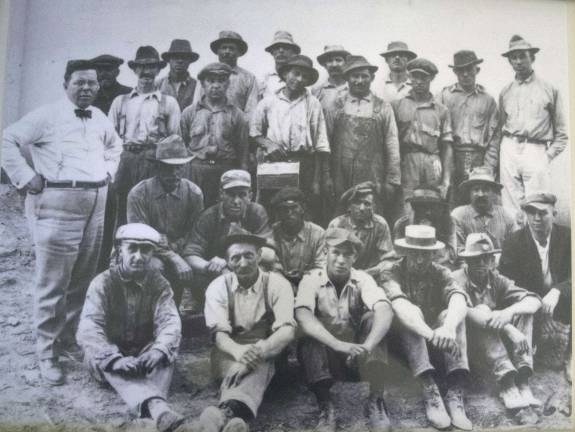Historical society explores Lime Crest Quarry

“Lime Crest Quarry: Eons in the Making, Men in the Mining” will open at the Sparta Historical Society’s Van Kirk Homestead Museum on Sunday, September 25. The first major exhibit held on this important and historic Sparta quarry will explore the geology, minerals, men, and companies that held an interest in the quarry’s development over the past 125 years including Thomas Edison’s involvement. Herbie, mascot of the Sussex County Miners baseball team, will also join us opening day from 1 to 2 p.m. Come for photos and enjoy the exhibit.
The exhibit began to take shape when the Sterling Mining Museum in Ogdensburg decided it was no longer interested in the model and photos of the quarry it had accepted many years prior. Sparta Historical Society’s Museum Director Jack Clark, a retired mineralogist and museum executive, took a special interest in the availability of this material. With another board member, Joe Warner, he visited Bill Kroth, president of the Sterling Mining Museum, to confirm the availability of the Lime Crest historic material and the fact that this was indeed the same material that had been offered to the Sparta Historical Society long before it had a home at the Van Kirk Homestead.
The collection was soon relocated to the Van Kirk Homestead where plans were initiated to hold an exhibit in its Changing Exhibition Gallery, a facility unique to the historical society that reinforces the educational story of more traditional galleries. The exhibit soon evolved into a much larger concept. First there would be a three month exhibit in the changing gallery but, after that, the Lime Crest material would become part of a larger “History of Mining in Sparta” story to be located in a mine-like basement area of the 225 year old Homestead.
Former Lime Crest president and owner, Paul Viall, now located in Virginia, took an enthusiastic interest in the project and, in turn, enlisted the interest of former mining colleagues throughout the country. Current owners, Braen Stone Industries, also became interested through their CEO and chairwoman, Janet R. Braen. All shared an interest in both telling the story of the historic quarry and preserving the documents related to its history before they are lost or forgotten.
The history of mining in Sparta includes a period when Thomas Edison was heavily involved with both iron and limestone. While he is most noted and remembered for his hundreds of electrical, sound, and movie-related inventions, his interest in mining became most evident in Sparta. With a personal fortune and major investment from John Pierpont Morgan, he purchased thousands of acres on top of Sparta Mountain to develop a large iron mining complex for over 500 miners and their families. With marginal success, the entire operation was shut down in 1899, a victim to more easily accessible iron ores in Minnesota’s Mesabi Range. With a price tag of over $3 million, this failure had a devastating impact on Edison’s financial resources. However, his fascination with mining remained undaunted.
He saw the opportunity to apply some of the processes he had developed for his iron venture to other mining efforts. His interest shifted to the production of Portland cement, a durable concrete first produced in England in the 18th century. Edison’s scientists researched the mixture and processes needed to make this product and, by 1901, had built kilns and processing facilities at New Village, NJ near Phillipsburg. By 1905, this facility was producing 3,000 barrels of cement per day from a nearby limestone quarry.
Thomas Edison did not discover the limestone/marble outcrop in Sparta. Photographs in the historical society’s collections show it being mined on a small scale in the mid-1890s. Owned and quarried by a local Sussex Mills farmer, the rock was the raw material for the production of agricultural lime in many locally-owned kilns. At the time, this was called the Crestmore Quarry. The need for additional raw material with high calcium lime content was rapidly growing and Edison knew of the Crestmore Quarry on the western edge of Sparta.
This quarry was leased by the Edison Portland Cement Company from 1906 to 1908. Ultimately, the cost of shipping by rail from Sparta to the New Village facilities proved too costly. The quarry, relatively inactive after Edison left, reopened in 1919 after its purchase by Limestone Products Corporation of America. The quarry’s name became Lime Crest. This company had a research lab that demonstrated that the calcium in limestone benefited the production of stronger egg shells when fed to chickens. They even had a spokes-chicken, Lady Lime Crest, who appeared on the Arthur Godfrey show!
After many lessees and owners the quarry is once again an active mine under the ownership of Braen Stone Industries. Today, the quarry is approximately 3000 feet in length, 1500 feet in width, and 300 feet deep.
The Sparta Historical Society’s Van Kirk Homestead Museum is located at 336 Main Street (Rte. 517, use Sparta Middle School driveway), Sparta. (Mail address: P. O. Box 312, Sparta, NJ 07871). This fall exhibit, sponsored by Braen Stone of Sparta, will be open every 2nd and 4th Sunday through December 11, 1-4 p.m. with a gallery walk at 2 p.m. For information or group tours, use email (SpartaHistoricalSocietyNJ@gmail.com) or call 973-726-0883.